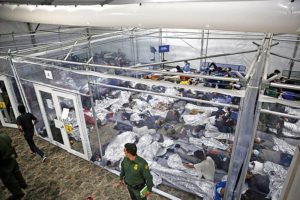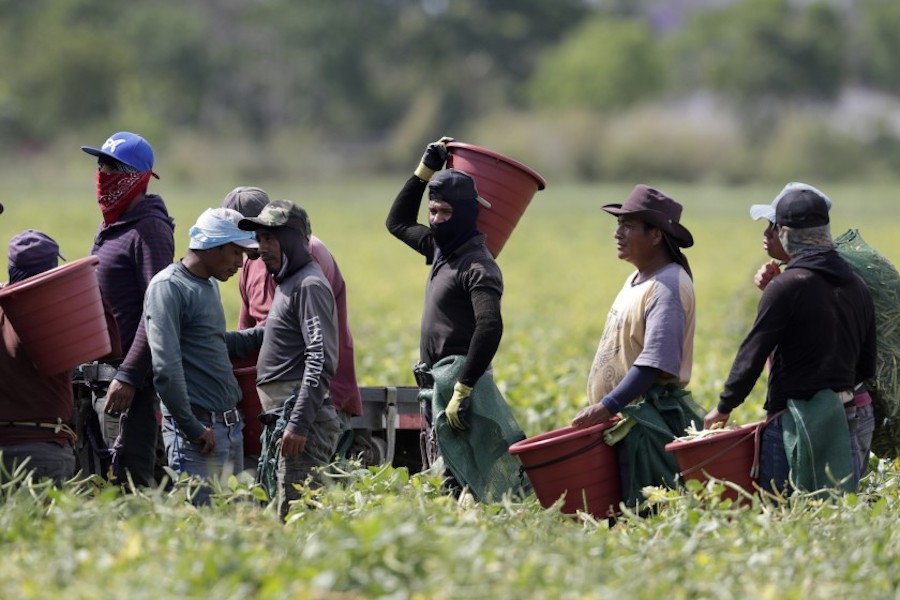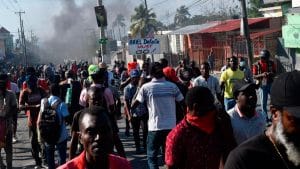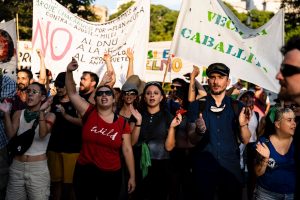An image taken in the streets of Tapachula, Chiapas, a city on the border with Guatemala, shows two Honduran children, one barely taller than the other, walking hand in hand alongside other migrants. They could be brothers, walking together with little more than the clothes on their backs. They have thousands of miles to go before they reach the so-called “American Dream.”
Though the subjects may differ, this image is repeated in the north of Mexico as well, in the migrant camps set up between large transnational companies and border crossings, under the sun and desert winds.

This photo, from a Detention Center in Northern Mexico, says it all about the future that the perilous journey to the southern border of the United States has in store for hundreds of thousands of migrants: detention centers, veritable children’s prisons, persecution, racism, and deportation. This is the true face of American democracy.
President Biden: Continuity in Anti-Immigrant Policies
The first months of 2021 have marked the beginning of a new immigration crisis. The number of arrests carried out in March alone were the highest since 2001. One third of these migrants are Mexicans, the rest come from Central America, particularly Honduras, El Salvador, and Guatemala.
Faced with the exponential increase in unaccompanied migrant children at the borders of Mexico and the United States, even the director of UNICEF, Henrietta Fore, was forced to put out a statement about the crisis. At a special virtual meeting on the “Humanitarian Situation in El Salvador, Guatemala, and Honduras” in April, Fore said, “These children arrive after perilous journeys of up to two months — alone, exhausted and afraid. Every step is a risk of violence and exploitation, recruitment to gangs, and trafficking, which has seen a three-fold increase over the last 15 years.”
The governments of the countries these migrants cross are undeniably responsible for these conditions. Crossing roads, borders, fields, cities, and the desert itself is one of the most dangerous journeys imaginable. In the case of Mexico, it is worth mentioning that, according to the Federation of Public Human Rights Organizations (FMOPDH), 2,000 migrants are officially registered as missing. Furthermore, 19 migrants were murdered in January by police in Camargo, Tamaulipas. Victoria Salazar, a Salvadoran refugee migrant, was killed by the police in Tulum, Quintana Roo. These cases are the direct result of state violence and drug trafficking, exploitation, and recruitment for gangs and cartels. The migrants who make the dangerous trek towards the United States from their home countries are constantly faced with the danger of rape and trafficking, not to mention the risk of exposure to Covid-19, without access to healthcare in the countries they pass through.
For decades, the United States has responded to such “immigration crises” by strengthening its repressive and containment apparatus, with the complicity of the Mexican government and the governments of Central America.
In 2014, under the leadership of Barack Obama — who was dubbed the “Deporter-In-Chief” by migrants rights organizations — the United States pressured Mexico to respond to the influx of migrants at the border by acting as another branch of border control south of the Rio Bravo. The government of Enrique Peña Nieto in turn created the Southern Border Program in Mexico, and ensured the escalation of repression by the National Institute of Migration (INM).
At the end of 2018 and during the first months of 2019, a new migratory influx provoked new threats from Donald Trump to the Mexican government. Mexican president Andres Manuel López Obrador (AMLO), newly elected to office, did not hesitate to comply. He immediately created a new repressive body, the National Guard, and deployed 20,000 troops across the country. Their first order was to contain the arrival of migrants to the Rio Bravo.
When he took office, Joe Biden promised a naturalization campaign for undocumented immigrants and the reactivation of protection for the so-called “dreamers,” or recipients of the DACA program that had been revoked under the Trump administration. This generated what anti-immigrant proponents across the world have fearfully called an efecto llamada or “call effect,” in which more migrants make the journey from their home countries to countries offering new legalization policies. Conservative hand-wringing aside, it is true that Biden’s rhetoric around a more “inclusive” approach to immigration has awakened widespread illusions in thousands of Central Americans and Mexicans who are trying to reach the U.S. border.
However, as Aaron Reichlin-Melnick of the American Immigration Council states, “It is false to say that the borders are open … In the last three months, about 70% of the people who entered were quickly removed thanks to a rule implemented last year by Trump in the pandemic and which Biden has maintained. Fewer families are being allowed to stay in 2021 than in 2019 under the Trump Administration.”
Indeed, while Biden may eschew much of Trump’s aggressive rhetoric, the numbers show the truth behind the administration’s immigration policy. To speed up deportations, Biden uses Title 42, which Trump crafted and subsequently implemented to expel half a million undocumented migrants and suspend de facto the right to asylum.
According to The Intercept’s Jeremy Scahill, “Title 42 is this obscure Centers for Disease Control law that the Trump administration, particularly Trump’s top immigration adviser, Stephen Miller, turned to at the beginning of the pandemic, to sort of achieve his long-standing goal of linking migrants to disease as a means to kind of lock-down asylum at the border, which had been his one of his primary objectives throughout the Trump administration’s four years in office.” The Biden administration’s use of this racist policy has led to thousands of deportations, many of them late at night, which dump migrants in Mexican cities or other remote points along the long border without any protection.
You might be interested in: Biden’s Reversal on Refugees Is an Attempt to Regain Hegemony
Biden has also zigzagged on several of his campaign promises related to immigration. He first announced that he would maintain the 15,000 annual refugee cap, which caused controversy and forced the president to overturn the decision. White House officials also initially accepted that some sections of the border wall would need to be completed as it worked on other “smart security investments” to contain immigration. After this sparked outrage amongst migrants rights activists, Biden also reversed this position, saying he would stop the construction of the wall and redirect those funds back to the Pentagon.
Political Tension in the Heart of the Empire
The massive influx of migrants opened political tensions and a crisis for the U.S. government in its first 100 days in office. To try to get the situation under control, Biden has put Vice President Kamala Harris in charge of negotiating with the governments of the region, while former Ambassador Roberta Jacobson resigned as his administration’s coordinator for the Southern Border. Harris has since held meetings with AMLO, as well as the president of Guatemala, Alejandro Giamattei, to discuss how to best resolve the crisis to the United States’ advantage.
GOP opposition has taken advantage of the situation to criticize Biden, holding him responsible for the increased flow of immigration. Senator Mitch McConnell has said that the administration’s policies at the border are “not fair to American citizens and workers.” Senator Lindsey Graham has said that the administration has “lost control” of the border. But even certain Democrats are echoing Republicans’ statements, as in the case of Bruno Lozano, the mayor of Del Rio in Texas, who called Biden’s response to the influx of migrants at the border “a slap in the face.” He told the White House, “We do not have the resources available to house and accommodate these migrants within our community.”
Meanwhile, Biden’s immigration plans, approved thanks to the Democratic majority in the House of Representatives, now face a Senate in which Biden lacks the necessary votes to pass the legislation. Republicans, such as Lindsey Graham, have said they will not support reform “until the situation at the border is brought under control.”
At the same time, Biden also faces pressure from the “left” wing of his own party. His backtracking on promises to expand the number of refugees aroused criticism in the “Squad” led by Alexandra Ocasio-Cortez. This sector of the Democratic Party is voicing opposition to the White House’s immigration policies in response to its own progressive social base, which risks becoming disillusioned if Biden reneges on his campaign promises. However, Ocasio-Cortez did not hesitate to state that “What is happening here is not the same as what happened during the Trump administration,” making excuses for her party’s anti-immigrant policies and sugarcoating the fact that ignominious rules such as Title 42 are still being used to deport and endanger migrants.
You might be interested in: The Politics of AOC
The immigration question is an important one for the Biden administration for a variety of reasons. It is a crucial point in his agenda, insofar as it crosses transversally the relationship with Mexico, with which he shares 3,000 kilometers of a porous border, a commercial treaty that shapes the daily productive and commercial exchange, and one of the most important value chains of the capitalist world economy. The same applies to Central America, which the United States considers its “backyard” and an area of immediate influence for the White House. For Washington, maintaining positive relations with Mexico and the governments of Central America is a priority. It is a necessary step to strengthen its weight in Latin America and shore up the hegemony it seeks to consolidate, in a context marked by economic and geopolitical disputes with other powers, such as China, and by the international economic and health crisis.
Biden also faces enormous pressure in the domestic sphere to respond to the crisis at the border. Migrants are a very important part of the U.S. labor force — particularly Caribbean, Mexican, and Central American migrants. This demographic is quickly rising in importance in the political arena, particularly as part of the Democratic electoral base. Immigration is also a crucial issue for many progressive, young, and working-class white voters, who make up another significant portion of the Democratic Party’s base.
Finally, in an extremely polarized U.S. political atmosphere, the Republicans are using the migrant issue as a battering ram to hit Biden’s popularity in his first year in power, responding to their own social and electoral base that was captivated by Trump’s anti-immigrant rhetoric and policies.
Imperialist Oppression: the Driving Force behind Migration
In recent years, thousands of Central American migrants have coordinated and organized themselves in “migrant caravans,” with the intention of bringing attention to their dire situation and creating some protection for themselves against the perils of the journey. A few months ago, thousands of Honduran migrants were rejected by the Mexican government and repressed by Guatemalan security forces at Mexico’s southern border. But though the caravans have received much attention from the media, Central American and Mexican migration is continuous along multiple paths and roads.
The persistence in undertaking this journey is the consequence of the United States’ imperialist plans for Mexico and Central America — the structural causes of migration lays in the near total state of economic and political dependence on the United States in the region. In recent decades, the intervention of transnational corporations in the economies of these countries, as well as the application of structural reforms mandated by the International Monetary Fund and the World Bank — made possible by the subordination of the different governments to the White House — have had grave results. In particular, the working class and poor in these countries face a staggering increase in misery, job insecurity, unemployment, and deteriorating living conditions. For example, 54 percent of children in Mexico and 70 percent of all children in Central America live in poverty. In addition, the vast majority of people in these countries suffer the consequences of the plundering of natural resources and lack of access to water, for the direct benefit of large companies.
Last year, these conditions were exacerbated in the context of the pandemic and the economic crisis. In 2020, Mexico’s GDPfell by 8.5 percent. For Honduras and El Salvador, GDP fell 9 and 8 percent, respectively. As in the rest of Latin America, the recovery in 2021 will not be able to overcome this abrupt fall. In addition, the effects of the recent hurricanes Iota and Eta, which hit Honduras in particular, have been devastating. Added to this are the effects of climate change and the plundering of water resources, which cause droughts that severely affect the agricultural sector, in which millions of people work. According to data from the UN Office of Humanitarian Affairs, 10 million people in the countries of the so-called “Northern Triangle” — El Salvador, Guatemala, and Honduras — are currently in need of humanitarian assistance in order to survive. That is about 25 percent of the total population, twice as much as at the beginning of 2020.
Another of the effects of imperialist domination is militarization and the so-called “War on Drugs,” which is fueled in part by arms trafficking from the United States. This decades-long imperialist assault has resulted in hundreds of thousands of dead, disappeared, and entire populations displaced. This is the direct responsibility of the White House, which imposed the so-called “Washington Consensus” and maintains an openly interventionist policy in the region. These are the conditions that expel and push hundreds of thousands of people to migrate, only to be faced with walls constituted by the repressive forces and migratory agencies of the United States, Mexico, and Central America.
Mexican “Progressivism” and Support for Anti-immigrant Policies
Faced with the migratory crisis, the compliance of the Mexican government is fundamental for the U.S. administration. Since the first meeting between López Obrador and Biden, the White House has sent 2.7 million vaccines and reinforced the presence of Mexico’s national guard at the borders. Although the bourgeois media, including the New York Times, assured readers of the existence of an “agreement” between the two countries, Mexico’s Foreign Minister Marcelo Ebrard tried to present Mexico’s deployment of troops and the shipment of vaccines as two unrelated issues, in a thinly-veiled effort to stave off accusations of a quid pro quo of vaccine imperialism.
The fact is that the U.S. government was able to guarantee an increase in militarization in the Latin American countries directly involved in the migration circuits. In the Mexican case, 10,000 troops were assigned to migration control, and a similar number of troops were deployed in each of the Northern Triangle countries.
Although López Obrador maintains a progressive rhetoric and assures the population that he is concerned for the interests of migrants, in practice, he accepts the migratory regulations imposed by Mexico’s northern neighbor and ensures the containment of Central American migration through the national guard. AMLO’s subordination is evident on an issue that is essential for the U.S. administration, which cannot be overshadowed by those aspects of the common agenda on which there are disagreements — such as the energy reform — which have been handled hermetically through diplomatic channels.
The real consequences of this subordination is that Central American migrants detained by Mexico’s National Institute of Migration face mistreatment, overcrowding, lack of sanitary protocols, and lack of adequate food. In addition, fast track deportations systematically hinder the right of Mexican migrants to asylum.
AMLO has openly supported and urged the White House to move forward with its “aid” plan for Central American countries, which would allocate $4 billion to the governments of these countries over four years. This U.S. initiative is part of an agenda to strengthen Mexico’s military presence at both of its borders and commits Central American governments to fight “corruption.” However, while these governments are historically aligned with Washington, they also maintain important links with the drug trafficking industry; for example, just this year the brother of Honduran president Juan Orlando Hernandez was sentenced to life imprisonment in the United States for drug trafficking.
You might be interested in: Immigration, Energy, and Security: The Mexico-U.S. Agenda
At the recent Climate Summit convened by the Biden administration, Lopez Obrador presented a proposal to extend his social program “Sembrando Vida” (Sowing Life), which is currently in place in Mexico, to Central America. Initially rejected by the U.S. president, this program now provides a minimum income ($250 per month) to Mexican farmers in exchange for planting and caring for trees on their plots. For Central America, this would be complemented with temporary permits to work in the United States for six months.
AMLO claimed that this proposal seeks to control the migratory flow in the region. But the reality is that it is a palliative solution, based on minimum remuneration, that will not be able to solve the structural conditions faced by Central American countries that drive migration. The promised temporary visas would not include, by their very nature, elementary rights for migrants. López Obrador maintains his illusion of convincing his U.S. counterpart that this proposal will provide the precarious and seasonal labor that is so necessary to the functioning of U.S. agriculture.
Behind the Borders is the Migrant Working Class
For those who face massive persecution and deportation and manage to get past border patrol, what comes next is highly precarious work with miserable wages and often dangerous working conditions, which are enshrined by their migratory status as “undocumented.” Migrants from Latin America and the Caribbean, both documented and undocumented, are a fundamental part of the United States’ “essential workers,” alongside the disproportionate numbers of people of color who were forced to work throughout the pandemic.
A recent report by the Center for Migration Studies stated that 69 percent of regularized migrants and 74 percent of undocumented migrants work in essential sectors, totaling 20 million people employed in health, agriculture, meat packing and poultry processing, construction, cleaning services, the food service industry, and logistics.
According to this same study, “The foreign-born comprise 33 percent of health care workers in New York State, 32 percent in California, 31 percent in New Jersey, 28 percent in Florida, 25 percent in Nevada and Maryland, 24 percent in Hawaii, 23 percent in Massachusetts, and 19 percent in Texas.”
During the pandemic, millions of Black and Brown workers in the United States did not enjoy the ability to telecommute, and had high exposure to Covid-19. As a result, they had higher infection and death rates: “as of August 25, 2020, a reported 37,500 workers in 416 meatpacking plants in 40 states had tested positive for COVID-19, and ‘at least’ 170 workers had died. These figures almost certainly undercount the numbers of meatpacking plant workers who have contracted COVID-19 and who have died from related complications.”
If before the pandemic most migrants did not have access to decent housing, basic services, or social security, they received very few of the benefits afforded by the government during the pandemic. Most were not eligible for the stimulus checks and protections of the CARES Act, showing that for the government and employers migrant workers are essential, but disposable.
One example of this is agriculture, where hundreds of thousands of Central American and Mexican migrants work. They face precarious conditions that make them highly vulnerable to the pandemic. Around half a million were infected with Covid-19 and some 9,000 died. States such as Arizona and Florida fiercely resisted declaring them essential and therefore deserving of protections.
In these circumstances, the Biden administration announced that it will approve 22,000 new H2-B visas for seasonal work, an amount that comes on top of the 66,000 already established as an annual limit. This measure is targeted towards the hotel, construction, and meat processing industries, among other sectors. This announcement is a response to the notorious drop in unemployment insurance applications in the United States, which is a consequence of the limited recovery of the economy after the 2020 downturn. In this context, U.S. companies require temporary migrant labor working in precarious and low-wage conditions.
Working Class Unity, Solidarity across Borders
The essential character of migrant workers, as well as the racism, xenophobia, and state violence they face, creates conditions similar to those faced by their Black and Brown brothers and sisters who, though classified as “citizens” in the United States, face the violent effects of structural racism. That is one of the causes that motivated the migrant community’s participation in a variety of labor protest movements and the fact that many Latinos also joined the mobilizations in repudiation of the murder of George Floyd. “Tu lucha es mi lucha” (Your fight is my fight) could be seen emblazoned across banners across the Black Lives Matter protests all over the country. Thousands of young Latinos participated in mobilizations in New York and other cities. An image of the protests in Phoenix showed the demand “Defund Police,” emphasizing in red the letters ICE (Immigration and Customs Enforcement). At the heart of the empire, the multiracial working class must build on this, incorporating and unifying the banners of struggle against exploitation, oppression, and xenophobia.
The dire circumstances faced by hundreds of thousands of migrants every day not only sheds light on the profoundly xenophobic and racist character of the U.S. state, which at the same time uses Latino and Black workers to increase the profits of the transnationals, but also shows the role of the Mexican and Central American governments, which are at the beck and call of their imperialist neighbor.
The fact that Mexico’s government has for years acted as U.S. border patrol on the other side of the southern border cannot be separated from the economic integration deployed during neoliberalism, which molded Mexico as an export platform according to the needs of its transnationals. Nor can it be separated from the profound social decomposition, spurred by the so-called “War on Drugs” and militarization imposed by Washington. In this way, the struggle against imperialist oppression is intimately linked to the fight for the rights of migrants, as well as the struggle of the U.S. working class against its own executioners, the Democrats and Republicans alike.
The powerful multi-ethnic U.S. working class — including, for example, teachers, Amazon workers, health care workers, and the youth — were the protagonists of protests during the pandemic over both labor issues and repudiation of racial violence, and have its allies in the Mexican and Central American working class. The defense of migrants, open borders, and full rights for all are crucial demands that should unify them beyond borders and walls.
On both sides of the border, to overcome the barbed wire fences and walls built by Democrats and Republicans, we must deploy an anti-imperialist and internationalist movement, led by the workers and independent of the different governments.
First published in Spanish on May 2 in Ideas de Izquierda Mexico.
Translation by Madeleine Freeman











